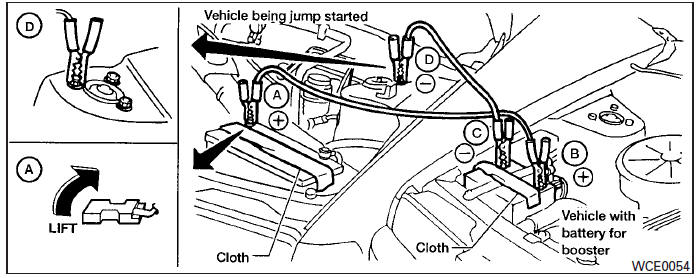Nissan Sentra Owners Manual: Jump starting
To start your engine with a booster battery, the instructions and precautions below must be followed.
WARNING
|

- Turn the ignition switch to the “LOCK” position.
- Remove the vent caps on the battery (if so equipped). Cover the battery with an old cloth to reduce explosion hazard.
- Connect the jumper cables in the sequence illustrated ( A , B , C , D ).
CAUTION
- Always connect positive ( ) to positive ( ) and negative ( ) to body ground (for example, strut mounting bolt, engine lift bracket, etc.) — not to the battery.
- Make sure the jumper cables do not touch moving parts in the engine compartment and that the cable clamps do not contact any other metal.
- Start the engine of the booster vehicle and let it run for a few minutes.
- Keep the engine speed of the booster vehicle at about 2,000 rpm and start the engine of the vehicle being jump started.
CAUTION
Do not keep the starter motor engaged for more than 10 seconds. If the engine does not start right away, place the ignition switch in the OFF position and wait 3 to 4 seconds before trying again.
- After starting the engine, carefully disconnect the negative cable and then the positive cable.
- Replace the vent caps (if so equipped). Be sure to dispose of the cloth used to cover the vent holes as it may be contaminated with corrosive acid.
 Changing a flat tire
Changing a flat tire
If you have a flat tire, follow the instructions below:
Stopping the vehicle
Safely move the vehicle off the road and
away from traffic.
Turn on the hazard warning flashers.
Park on a level ...
 Push starting
Push starting
CAUTION
Do not push start this vehicle. The
three-way catalyst may be damaged.
Continuously Variable Transmission
(CVT) models and Manual Transmission
(MT) cannot be push-started or towsta ...
Other materials:
Wiring diagram
AUTOMATIC AIR CONDITIONING SYSTEM
Wiring Diagram
...
Keyfob (if so equipped)
Replace the battery in the keyfob as follows:
Remove the screw A .
Insert a small screwdriver into the slit of the
corner B and twist it to separate the upper
part from the lower part. Use a cloth to
protect the casing.
Replace the battery with a new one.
Do not touch the int ...
Bluetooth® Hands-Free Phone System with
Navigation System (if so equipped)
WARNING
Use a phone after stopping your vehicle
in a safe location. If you have to use a
phone while driving, exercise extreme
caution at all times so full attention may
be given to vehicle operation.
If you are unable to devote full attention
to vehicle operation ...
